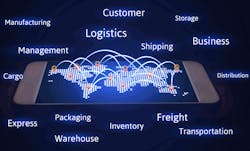The future of digitalization within supply chains has the industry sitting up and taking notice. Our community of supply chain professionals is certainly putting digitalization at the top of the agenda as companies are looking to invest heavily in new technologies that will improve the end-to-end supply chain. While it can be said that digitalization itself is not a new process, the extent to which it is being made a priority—by not only the chief information officers (CIOs) but also the chief supply chain officers (CSCOs)—is significant.
SCM World's recent 2016 Future of Supply Chain report highlights the increasing importance of digitalization within the supply chain function. Over 1,400 supply chain practitioners named Big Data analytics, cloud computing, advanced robotics, IoT and machine learning as "disruptive and important" technologies.
So, what are the main challenges facing CSCOs that are driving the need for strategic digitalization within the end-to-end supply chain?
Playing Catch Up with Consumers
Business digitalization is falling way behind that of the consumer world. In our private lives, we've been quick to adopt new technologies, but this has yet to be reflected in the way we do business.
As consumers, we have far more choice available to us, and we can order what we want with just a tap on our smartphones. Thanks to the popularity of apps from companies such as Amazon, Uber and Just Eat, the everyday customer now expects the global supply chain to be able to deliver what they want immediately. Like consumers, B2B customers can be picky and impatient, and they certainly expect the same access to customized products at affordable prices.
Neglecting technological innovation within the supply chain to address this demand will only damage the ability of companies to keep up with the changing buying demands of consumers.
Drowning in Data
Businesses are working with an unprecedented flow of data. Billions of devices—both upstream in manufacturing as well as downstream at the point of sale—are generating enormous amounts of data, every moment of the day.
This is leading to what can only be described as "digital obesity." While much of the data can be incredibly useful for organizations, as the enormity of it grows, it becomes increasingly difficult to distinguish the useless data from the few nuggets that really matter.
How Can Companies Adapt?
Leading CSCOs recognize that the importance of digitalization stems from the need to respond to the formidable speed, accuracy and quality that everyday consumers and business customers expect from supply chains. However, C-level executives must also understand that digitizing the end-to-end supply chain is not an easy undertaking, and requires a completely different approach compared to past technology investments.
With this is mind, true supply chain digitalization will only happen once businesses follow three key recommendations:
1. Understand that digitalization is a business strategy, rather than a technology implementation. Digitalization should mean more than a simple update to existing IT systems. Effective supply chains don't operate within silos; they interconnect each moving part to form an end-to-end operation. Therefore, digital solutions need to be viewed across the entire supply chain and linked together to address each individual challenge along the way.
To ensure this happens efficiently, many companies are turning to designated chief digital officers (CDOs) to drive strategic digitalization, while others have handed the responsibility to the CSCO or the chief operating officer (COO). It is crucial that whoever is given ownership of the digitalization roadmap sits at the board level.
3. Invest in tech training for staff to ensure digitalization doesn't create division. While people are very much used to technology being present in their personal lives, the speed at which technology solutions will mature within a work environment is likely to present a challenge to their digital skills. This added pressure means that it is critical for companies to invest in ongoing training in new technology to prepare employees for digital transformation and address any fears of job disruption. It is also essential to recruit younger digital natives who can quickly adapt to any changing digital strategies.
Companies need to appreciate that the benefits of digitalization go beyond mere cost reduction. New supply chain technologies can provide a faster, more accurate and highly-optimized product lifecycle, from new product development to customer fulfillment. Businesses can use new solutions to shorten time to market and improve the customer experience, and both are key to surviving in today's fast-paced digital world.
Pierfrancesco Manenti is research vice president with SCM World, a cross-industry community of more than 100 global organizations. SCM World is a Gartner community.






